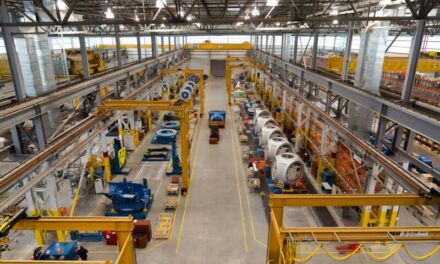Based in Germany, Hamburg-Ahrensburg offset printers are supported by a DataMan® 500 integrated image-based barcode reader from Cognex which has guaranteed smooth and accurate logistics, whilst lowering investment, maintenance and repair costs.
Axel Springer has been printing newspapers for northern Germany since 1983, in addition to publications on behalf of other publishers. This is where the words of Das Bild, the Hamburger Abendblatt, Die Zeit and many other print papers are produced and shipped to readers. Barcodes are used to pack the newspapers into bundles to make sure they not only arrived quickly but also at the right address. For three decades the barcodes were read using a laser scanner with a tilting mirror, but recently this mature technology was replaced by the next generation of barcode readers: Cognex image-based logistics barcode readers, which ensure high precision identification. The intelligent DataMan 500, integrated by bci GmbH and operational technology staff into the component systems of Axel Springer AG, reads the barcode codes at lightning speed and with 100 percent reliability.
Surface reflections
Anyone who has ever passed a newspaper kiosk early in the morning will be familiar with the piles of newspapers wrapped in plastic. The machines at the Hamburg-Ahrensburg offset printing press stack newspapers in piles up to 10 inches high (depending on the order quantity), put a covering sheet on top with 1-D codes, wrap the pile in transparent plastic and finally tie it up cross-wise with plastic packaging straps. The DataMan 500 reads the codes immediately after this step as the package passes along the conveyor belt. A combination of codes on coloured paper which are often creased creates a highly reflective surface. This was a real challenge for the bci GmbH experts and was the key factor in the decision to choose the Cognex DataMan 500 barcode reader.
It was clear when the Axel Springer AG project started in November 2011 that the laser scanner was coming to the end of its operational life. Wear and tear on the tilting mirror and other movable parts was too great and the resulting maintenance and follow-up costs were too high. It was also becoming increasingly difficult to get hold of replacement parts for the aging equipment and the read failure rate was no longer acceptable. A decision was made to replace it with modern, image-based ID reading equipment from Cognex, which are designed with no moving parts that wear out.
Traceability
The high performance DataMan 500 made it possible for bci GmbH to achieve 100 percent reliability in reading the barcodes after a test phase of just four weeks. And that was for newspaper bundles ranging in height from 0.5 to 10 inches and variations in the position of the code over a range of 15 inches plus. That was no problem for the DataMan 500 because of its depth of field capabilities. To make maximum use of the reader’s potential, bci prioritised customer-specific programming. These complex challenges were overcome rapidly in a number of test runs.
Filtered light
The DataMan 500 only needs one master setting to manage the incoming packs of highly reflective newspapers with their different heights and varying positions. The intelligent DataMan utilises an HPIA (high-powered illumination accessory). Both the DataMan 500 lens and the additional light source are fitted with polarising filters, which effectively reduce the cross-fade produced by the packaging foil.
Because the pilot project is running so reliably, Hamburg-Ahrensburg offset printers are planning to replace the aging laser scanners throughout the system with Cognex barcode reading equipment in the medium term. The reasons for doing this are the lower investment costs and the reduction in maintenance costs.
With an eye on the future, the flexibility of DataMan 500 is also a significant plus for Axel Springer, as it will be easy to reprogram the Cognex image-based barcode reading equipment if they switch to using 2-D codes in the near future. And as a final bonus, the DataMan 500 even consumes significantly less electricity than the laser scanner.


